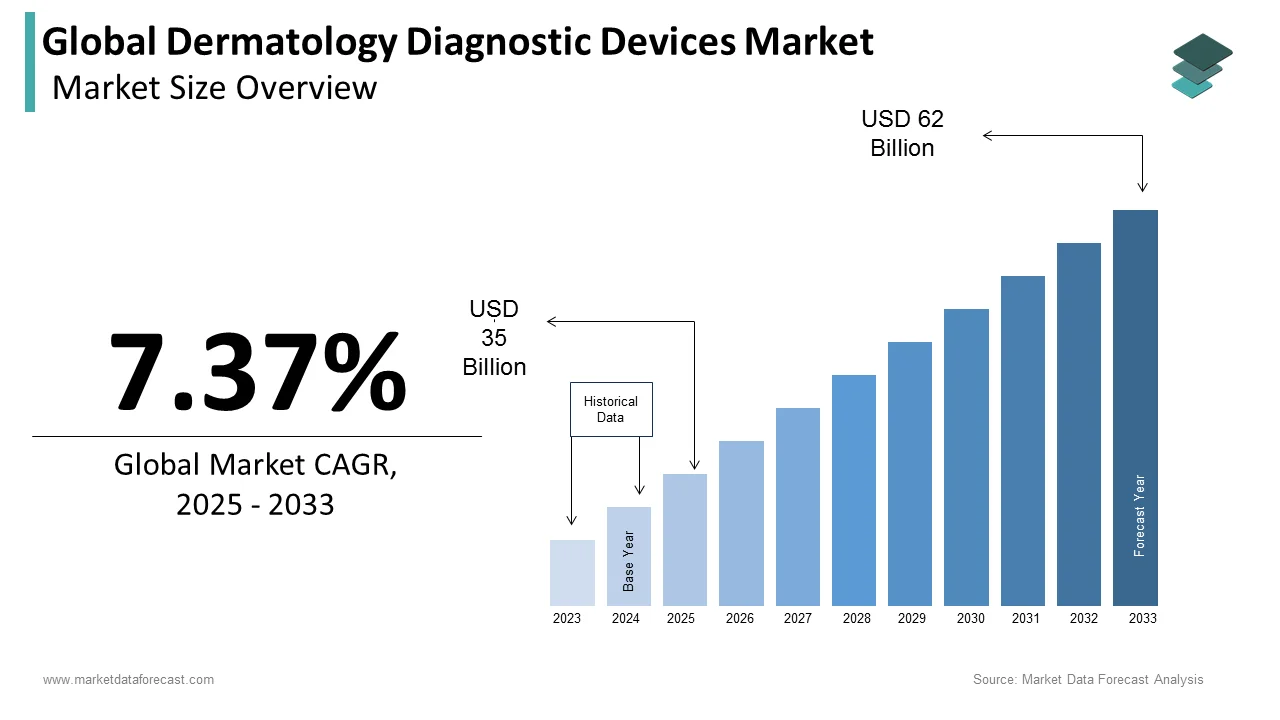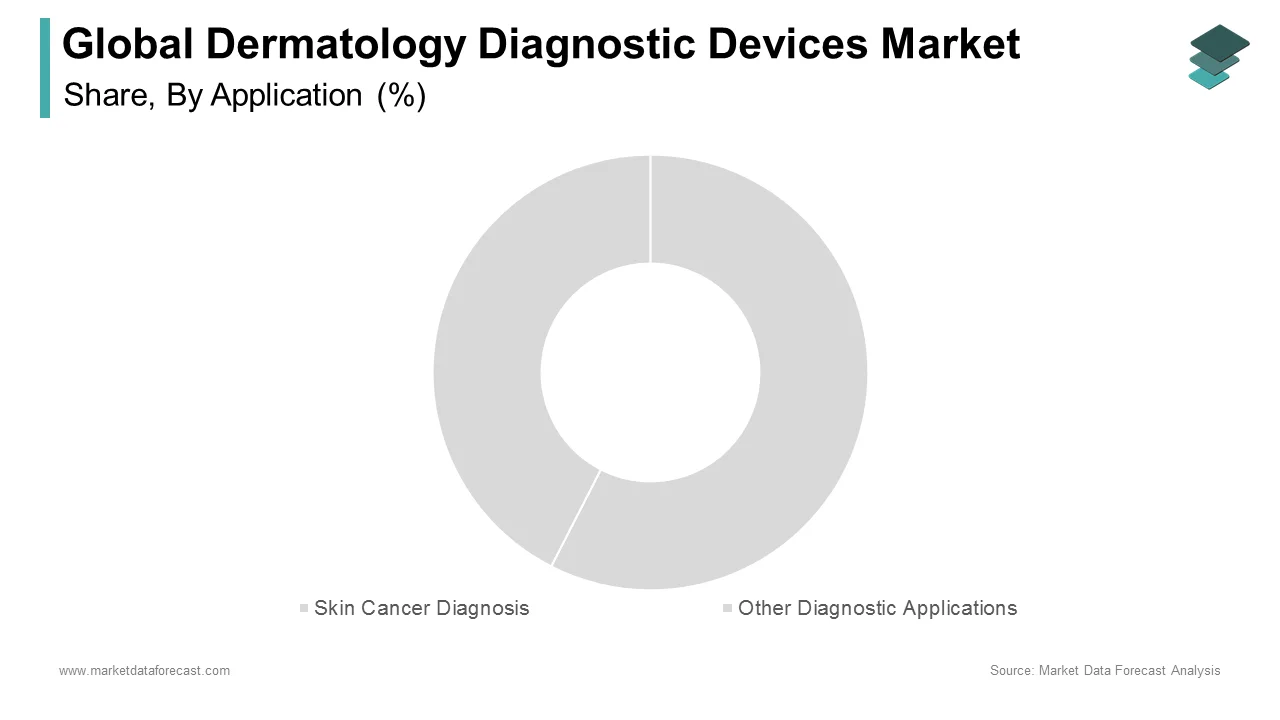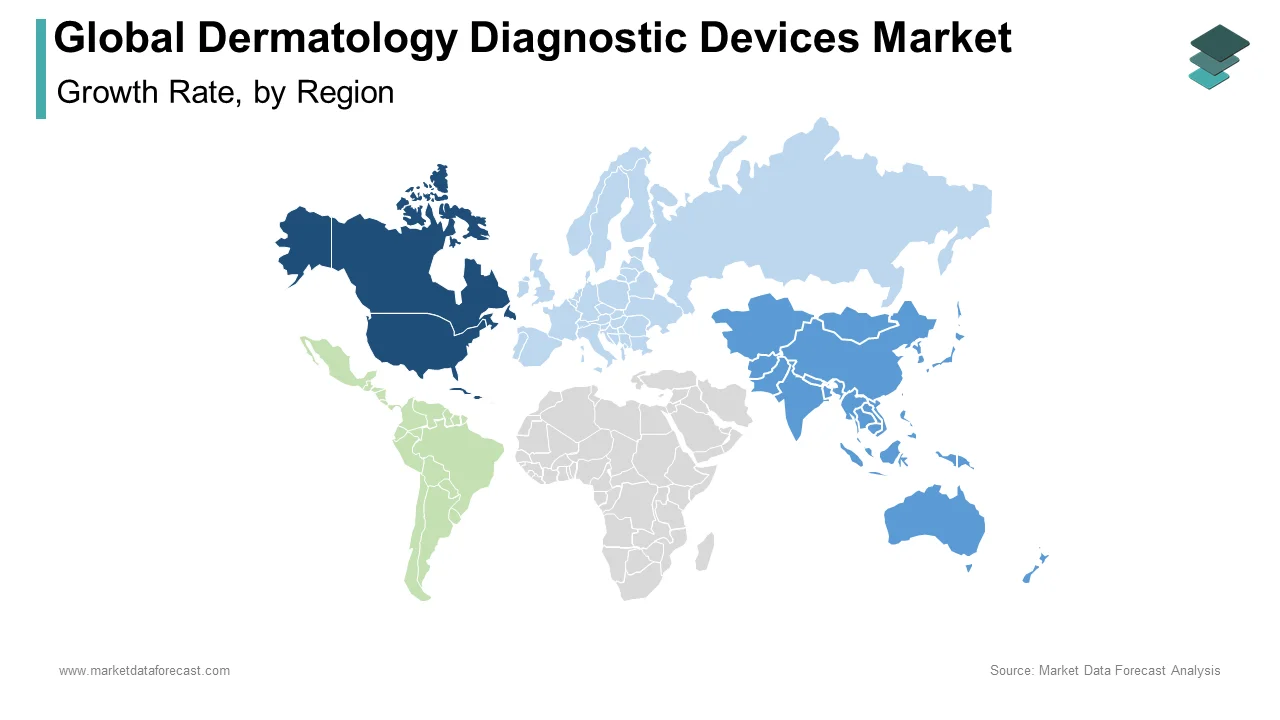Global Dermatology Diagnostic Devices Market Size, Share, Trends & Growth Forecast Report By Type, Application, Dermatoscopes and Region (North America, Europe, Asia-Pacific, Latin America, Middle East and Africa) – Industry Analysis (2024 to 2032).and Region (North America, Europe, Asia-Pacific, Latin America, Middle East and Africa), Industry Analysis From 2025 To 2033.
Global Dermatology Diagnostic Devices Market Size
The global dermatology diagnostic devices market was worth US$ 33 billion in 2024 and is anticipated to reach a valuation of US$ 62 billion by 2033 from US$ 35 billion in 2025, and it is predicted to register a CAGR of 7.37% during the forecast period 2025-2033.

Dermatology Diagnostic Devices are the devices that are used to treat different skin diseases. Dermatology is one of the major markets in the healthcare industry. Dermatology diagnostic devices are imaging devices, microscopes, dermatoscopes, and other devices. This diagnostic equipment is being utilized for skin-related diseases & treatment also. In the last few years, the use of these diagnostic devices has been rising rapidly. Several countries invest in dermatological diagnostic devices to treat diseases such as psoriasis, leukemia, hive, rosacea, etc.
MARKET DRIVERS
The growing incidence of skin-related diseases worldwide is majorly attributing the growth to the dermatology diagnostic devices market.
The increasing prevalence of melanoma and other skin-related diseases primarily boosts the market growth of dermatology diagnostic devices. According to the American Cancer Society, an estimated 96,000 new melanoma cases were diagnosed in the United States in 2019. As per the Cancer Statistics Center, 100,350 new melanoma cases and 6,850 deaths are estimated to report in the United States by the end of 2020. New devices have been developed in the U.S. using artificial intelligence (AI) to diagnose skin cancer. However, the researcher is still developing dermatology devices for detection due to less accuracy. The U.S. Food and Drug Administration (FDA) conducted meetings about dermatology diagnostic devices used for the treatment of skin diseases, which drives the market growth forward. Increasing home-based devices to treat skin conditions will drive the market forward in the coming years. The availability of intense pulsed light, radiofrequency, light-emitting diodes, laser diodes, and ultraviolet B phototherapy made this growth possible.
Skin rejuvenation and rising beauty consciousness in people (both men and women) are further anticipated to drive market growth to dermatology diagnostic devices. Furthermore, in Hospitals & clinics, an increasing number of treatment options & facilities will gain the market of diagnostic devices. In addition, the rising demand for non-invasive cosmetic procedures for skin disorders drives market growth.
MARKET RESTRAINTS
The diagnostic devices have high prices & expensive and are hampering the market growth of dermatology diagnostic devices. In addition, advanced technology requires specialists, but practitioners don't know how to handle more effective skin diseases; it can reduce the diagnostic device market and the practitioner who works under dermatologists.
REPORT COVERAGE
|
REPORT METRIC |
DETAILS |
|
Market Size Available |
2024 to 2033 |
|
Base Year |
2024 |
|
Forecast Period |
2025 to 2033 |
|
CAGR |
7.37% |
|
Segments Covered |
By Application, Type, Dermatoscopes, and Region. |
|
Various Analyses Covered |
Global, Regional, and country-level analysis; Segment-Level Analysis, DROC; PESTLE Analysis; Porter’s Five Forces Analysis, Competitive Landscape; Analyst Overview of Investment Opportunities |
|
Regions Covered |
North America, Europe, APAC, Latin America, Middle East & Africa |
|
Market Leaders Profiled |
Alma Lasers, Ltd., Cutera, Inc., Cynosure, Inc., Lumenis, Ltd., Valeant Pharmaceuticals International, Inc., Gen, Inc., Bruker Corporation, Carl Zeiss, Genesis Biosystems, Inc. and Heine Optotechnik GmbH & Co. Kg., and Others. |
SEGMENTAL ANALYSIS
By Application Insights

Based on Application, the skin cancer diagnosis segment is expected to account for the largest share of the market during the forecast period. Melanoma, a skin cancer disease that has occurred worldwide, is the 17th most common cancer worldwide. It is occurred more in men compared to women. According to the Skin Cancer Foundation report, one in six Americans may develop skin cancer in their life. This melanoma skin cancer starts from the pigment-making cells of the skin, and it is more likely to grow slowly. Therefore, early diagnosis and treatment are essential to cure the disease. Researchers have developed an advanced handheld device to detect different types of skin cancer.
By Type Insights
Based on Type, the imaging devices category is anticipated to command the largest share of the market during the forecast above period. It is due to technological advancements and rising awareness regarding aesthetic procedures. Machine-based learning is used in imaging diagnostic devices. In addition, there are 3D imaging systems that capture a clear picture of the part that we have to make analyses for the disease treatment.
By Dermatoscopes Insights
The Hybrid Dermatoscopes segment has the highest market share. Dermoscopy is used to diagnose skin lesions and mainly for skin cancer. Hybrid dermoscopy is used to examine the skin lesion and closely improve workflow. This device is a lightweight handheld device that doctors or persons use to examine diseases such as melanoma. It is also used for people to examine the scalp, hair, and nails.
REGIONAL ANALYSIS

North America, Europe, and Asia dominate the global market. North America is likely to lead the market in the forecast mentioned above, owing to the steady presence of numerous regional healthcare sector players. Skin cancer is one of the most common cancers among many people in the U.S. One in ten Americans will develop this skin cancer in a lifetime. Nearly 10,000 people in the United States are diagnosed with skin cancer daily. By considering all these factors, the market has grown in this region. Teledermatology is the new way to virtually treat dermatology problems and chronic skin conditions due to a pandemic's restrictions. It allows the patient's health information and images can be sent securely to the trained dermatologist for further treatment. Canada uses this technology by keeping in e-consult fees for a dermatologist and giving the patients appropriate treatment through government undertook platform websites.
Asia is anticipated to experience the highest CAGR during the forecast mentioned above, with the development of this market centered on Japan, China, and India. Increasing incidence of skin diseases, rising healthcare expenditure, and awareness regarding aesthetic procedures are attributable to the observable trend mentioned above. Due to the Covid-19 pandemic, India also adopted the tele dermatology, in which treatment is done through video conference. Most dermatologists prefer this platform for the reduction of the virus spread. They encourage their patients to take sessions through video conference by boosting them by providing benefits of teledermatological. Advanced technologies such as Artificial Intelligence (A.I.), the Internet of Things (IoT), Big Data, and machine learning collect data securely. Due to increasing awareness of the consumer about their appearance in India, China, and Japan, the dermatology diagnostic devices market has the highest market share. The increasing aging population also drives the market in this region. Due to the growing popularity of geriatric dermatology in India, the market is growing steadily in this region. India has crossed the United Nations' aging population above 60 years old. Dermatologic issues of an aging population are more compared to those below 60 years of age. Pigmentation is a significant disorder in older people who use these dermatology devices for treatment.
As per Medical Device Regulations in Europe, the manufacturers are focusing on developing devices based on the importance of the dermatologist and gathering information on the highest skin disease that people are suffering from. Nearly half of Europeans have skin diseases such as fungal infection, itching, burning, etc. In addition, some other diseases, such as acne, pigmentation, atopic dermatitis, etc., occur in one in every seven people in Europe. Therefore, the European Academy of Dermatology and Venerology found the main burden of skin disease in Europe and found the best treatment through the device for those people.
One of the most common dermatological problems among people in Mexico is pigmentary disorders. In addition, some of the most common skin disorders in Mexico and Latin America are facial post-inflammatory hyperpigmentation, melasma, and solar dermatitis. During the last few years, dermatology care in this region has been increasing, which drives the market forward.
KEY MARKET PARTICIPANTS
Major Competitors in the Global Dermatology Diagnostic Devices Market profiled in the report are Alma Lasers, Ltd., Cutera, Inc., Cynosure, Inc., Lumenis, Ltd., Valeant Pharmaceuticals International, Inc., Gen, Inc., Bruker Corporation, Carl Zeiss, Genesis Biosystems, Inc. and Heine Optotechnik GmbH & Co. Kg.
RECENT MARKET HAPPENINGS
- In 2021, Lancer Skincare joined ByondXR to launch a Virtual Dermatology Shop. This will provide customers with the in-home benefits of the Lancer Dermatology practice.
- In 2021, The U.S. dermatology business of Ra Medical had an agreement with STRATA Skin Sciences, Inc. to develop advanced products for treating dermatologic disorders.
- In 2022, The Vascular Birthmarks Foundation announced that VBF Milan Free Laser Clinic by the people Dr. Giacomo Colletti, Co-Director of VBF Europe, Dr. Matteo Tretti Clementoni, Founder, CEO, and Medical Director of Laserplast and Candela Corporation are grouped to form this clinic. This is used for both adults and children.
- In 2021, Canfield Scientific, Inc. partnered with Medici Medical s.r.l. to create a medical dermatology education program for advanced dermatology products.
- In 2021, Alma launched the new Alma PrimeXTM platform for treating skin disease reduction and skin tightening in the waist, thigh, and abdomen areas.
MARKET SEGMENTATION
This research report on the global dermatology diagnostic devices market has been segmented and sub-segmented based on application, type, dermatoscopes, and region
By Application
- Skin Cancer Diagnosis
- Other Diagnostic Applications
By Type
- Imaging Devices
- Dermatoscopes
- Microscopes
By Dermatoscopes
- Contact Oil Immersion Dermatoscopes
- Cross-Polarized Dermatoscopes
- Hybrid Dermatoscopes
By Region:
- North America
- Europe
- Asia-Pacific
- Latin America
- Middle East and Africa
Frequently Asked Questions
How much is the global dermatology diagnostic devices market going to be worth by 2032?
As per our research report, the global dermatology diagnostic devices market size is estimated to grow to USD 62 Billion by 2033.
Which region held the largest share of the dermatology diagnostic devices market in 2024?
Based on the region, the North American market led the dermatology diagnostic devices market in 2024.
Who are the major players operating in the dermatology diagnostic devices market?
Major Competitors in the global dermatology diagnostic devices market profiled in the report are Alma Lasers, Ltd., Cutera, Inc., Cynosure, Inc., Lumenis, Ltd., and Valeant Pharmaceuticals International, Inc.
Related Reports
Access the study in MULTIPLE FORMATS
Purchase options starting from
$ 2500
Didn’t find what you’re looking for?
TALK TO OUR ANALYST TEAM
Need something within your budget?
NO WORRIES! WE GOT YOU COVERED!
Call us on: +1 888 702 9696 (U.S Toll Free)
Write to us: sales@marketdataforecast.com
